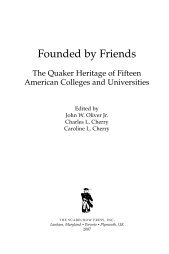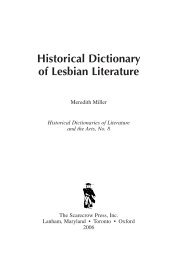Postwar German Cinema and the Horror Film - Scarecrow Press
Postwar German Cinema and the Horror Film - Scarecrow Press
Postwar German Cinema and the Horror Film - Scarecrow Press
You also want an ePaper? Increase the reach of your titles
YUMPU automatically turns print PDFs into web optimized ePapers that Google loves.
xxii Steffen Hantke<br />
Americanism of Cold War politics behind <strong>the</strong> Iron Curtain—but no horror films. Not a<br />
single one. Why not? Can horror film not be made to serve <strong>the</strong> interests of a totalitarian<br />
regime? Why do <strong>the</strong> monstrous abjections of horror cinema not lend <strong>the</strong>mselves to <strong>the</strong><br />
vilification of enemies of <strong>the</strong> ruling elite? Why does horror cinema appear to be useless<br />
to <strong>the</strong> requirements of political propag<strong>and</strong>a? These are questions for ano<strong>the</strong>r time <strong>and</strong><br />
place, yet questions that may be crucial for a critical assessment of <strong>the</strong> politics of horror<br />
film.<br />
9. Exceptions to <strong>the</strong>se accounts that place so much emphasis on <strong>German</strong> expressionist<br />
filmmaking tend to be <strong>the</strong>matic histories: Reynold Humphries’ The American <strong>Horror</strong><br />
<strong>Film</strong>: An Introduction, <strong>and</strong> Darryl Jones’ <strong>Horror</strong>: A Thematic History in Fiction <strong>and</strong><br />
<strong>Film</strong>. Both mention <strong>German</strong> expressionist films as examples of genre archetypes, <strong>the</strong>mes,<br />
<strong>and</strong> stylistic idiosyncrasies, but are not interested in determining to what degree <strong>the</strong> style<br />
of prewar <strong>German</strong> filmmakers has had a lasting effect on <strong>the</strong> genre of horror film. See<br />
Darryl Jones, <strong>Horror</strong>: A Thematic History in Fiction <strong>and</strong> <strong>Film</strong> (London: Arnold, 2002)<br />
<strong>and</strong> Reynold Humphries, The American <strong>Horror</strong> <strong>Film</strong>: An Introduction (Edinburgh: Edinburgh<br />
University <strong>Press</strong>, 2002).<br />
10. Klaus Kreimeier, in his history of <strong>the</strong> <strong>German</strong> Ufa, keeps using <strong>the</strong> expression<br />
“<strong>the</strong> ‘gothicizing’ films of <strong>the</strong> Weimar Republic” (109) instead of using genre terminology.<br />
11. Gruenberger goes on to classify Das deutsche Kettensägenmassaker as political<br />
satire.<br />
12. In Dreadful Pleasures: An Anatomy of Modern <strong>Horror</strong>, James Twitchell underwrites<br />
this notion of <strong>German</strong> horror classics as “art films” by contrasting directors like<br />
Murnau with those working in popular culture. An “important” film like Murnau’s Nosferatu<br />
is not interested in “advancing <strong>the</strong> myth [of <strong>the</strong> vampire]” but instead “promulgate[s]<br />
one particularly self-conscious version” of this myth (Twitchell 141).<br />
13. “…horror production by <strong>the</strong> <strong>German</strong> film industry [after <strong>the</strong> disruption of cinematic<br />
traditions during <strong>the</strong> Third Reich] did not return in any significant form until <strong>the</strong><br />
late 1960s” (Halle, “Unification <strong>Horror</strong>” 284).<br />
14. Kreimeier sees <strong>the</strong> Ufa style more as a set of production practices than a concrete<br />
<strong>and</strong> discernible set of visual conventions: “a strong capital base, squ<strong>and</strong>ered carelessly,<br />
a talent for large-scale organization <strong>and</strong> a tendency to go astray in microscopic<br />
detail; devotion to artistic excellence <strong>and</strong> to its perversion, which was empty perfectionism;<br />
a delight in <strong>the</strong> imaginative use of technology <strong>and</strong> in its reverse, which was mere<br />
technical slickness; a quest for philosophical power, but pursued in an intellectual vacuum;<br />
a ‘will to form’ that produced an amorphous ruin; craftsmanship, imagination, <strong>and</strong><br />
diligence, <strong>and</strong> <strong>the</strong> waste of all those virtues through intellectual arrogance <strong>and</strong> <strong>the</strong> lack of<br />
a governing concept” (152). Kreimeier continues: “This interplay between perfectionism<br />
<strong>and</strong> inarticulateness, like that between mysticism <strong>and</strong> intellectual vapidity in <strong>the</strong> plot of<br />
Metropolis, was part of <strong>the</strong> ‘Ufa aes<strong>the</strong>tic …’” (155).<br />
15. “. . . dies war ein Programm gegen die ‘Wirklichkeit’ und eine Absage an<br />
jeglichen Realismus. Seine Gestalt gewann dieses Konzept jedoch in höchstens zehn bis<br />
fünfzehn Werken, die als ‘klassische’ deutsche Stummfilme, heute zum ‘unvergänglichen<br />
Erbe’ der Kinematographie zu zählen sind” (Kreimeier 125–6).<br />
16. For a more detailed discussion of film careers across <strong>the</strong> historical turning-point<br />
of <strong>the</strong> Zero Hour, see Sabine Hake, “The Legacies of <strong>the</strong> Past in <strong>the</strong> <strong>Cinema</strong> of <strong>Postwar</strong><br />
Reconstruction,” in Popular <strong>Cinema</strong> of <strong>the</strong> Third Reich (Austin: Texas University <strong>Press</strong>,<br />
2001), 210–31.
















